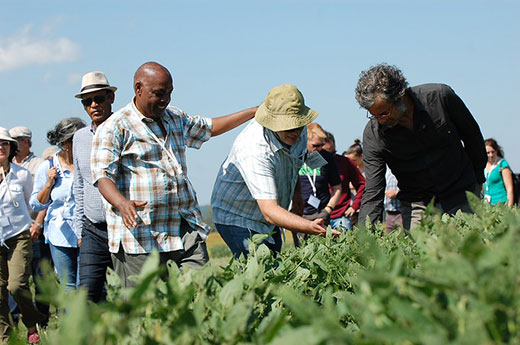
Participants in the recent Global Agenda for Sustainable Livestock meeting take a look at a row of soybeans during a stop at the Ashland Bottoms Research Farm south of Manhattan, one of several tours during the four-day meeting. | Download this photo.
Around the globe, farmers seek healthy animals, environment
K-State’s DeRouchey sees common thread among world’s livestock producers
September 17, 2019
MANHATTAN, Kan. – They came from around the world, nearly 300 strong, to talk about raising farm animals safely and protecting natural resources.
And when the participants of the annual meeting of the Global Agenda for Sustainable Livestock left Kansas State University last week, there was a similar message they all shared.
“What I was really intrigued by was the amount of people involved around the world who have the common goal of improving animal agriculture,” said Joel DeRouchey, a livestock specialist with K-State Research and Extension, who attended and presented at the conference.
As part of the United Nations’ Rome-based Food and Agriculture Organization, GASL meets annually to initiate discussions from varied perspectives so the livestock industry can respond to its biggest challenges. This year’s meeting was focused on innovations in the livestock industry, and their contributions to sustainability and care for the environment.
The four-day conference followed by a day of internal meetings Sept. 9-13, marked the first time the GASL event was conducted in the United States, and the first time hosted by a university. Participants came from 22 countries, including the U.S.
“It was interesting to me to try and get different perspectives of raising livestock based on where (participants) come from, and realize how many countries are dependent upon more developed countries such as the U.S. to be a global food leader,” DeRouchey said. “In several countries where they are experiencing population increases, they’re simply not able to increase production in their own livestock systems to meet their needs.”
DeRouchey pointed to the fact that all of agriculture is dealing with discussions on how to safely produce more food on the same amount of land, considering that estimates peg the world’s population to swell to about 9.7 billion by the year 2050.
Put another way, agriculture – the livestock industry included – will have to produce as much food over the next 30 years as it has in all of the years of the world’s history before that.
“A theme everyone recognized, whether you have one cow or you’re running a large herd in central Kansas, is that economics plays into sustainability,” DeRouchey said. “I never heard a disagreement on that. I think it’s just really defining how we move forward as an industry in the next several decades in terms of how we produce livestock to feed a growing population.”
DeRouchey said he heard many discussions during the meeting that addressed other important issues, such as how the industry reaches consumers with products and information; the introduction of such advances as biotechnology and gene editing; and the welfare of animals.
“There are certain levels of consumers that want to know everything from start to finish about the product they’re eating. But if we look at the majority of the population around the world, while they certainly care and don’t want things done wrong in terms of raising anything they eat, they want something that’s safe and affordable,” DeRouchey said.
Regarding technology, DeRouchey said: “I think people recognize that we can’t be in agriculture of the 1940s and 1950s in a modern world that has all of the advancements.
“It’s important how we embrace some of these technologies, get them through the regulatory system so we can implement them, and how we work with consumers so that they recognize that these different management practices are safe.”
DeRouchey said hosting the meeting was an exciting opportunity for the university.
“I think it speaks to the reputation of the College of Agriculture and Kansas State, being a land grant system that is truly rooted in the meaning of a land grant in terms of food and fiber and different production aspects as well as embracing technology and pushing things forward in the basic sciences,” he said.
Learn more about the Global Agenda for Sustainable Livestock and this year’s meeting at http://bit.ly/GASL-2019.

